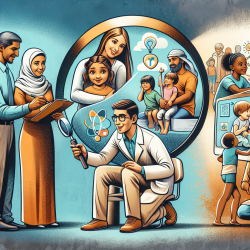Introduction
In the realm of youth mental health, early detection and intervention are critical. The study titled "Detecting young people with mental disorders: a cluster-randomised trial of multidisciplinary health teams at the GP office" provides valuable insights into improving the detection of mental disorders among young people. This blog aims to explore the study's findings and discuss how practitioners can enhance their skills and outcomes by implementing these insights.
Study Overview
The study conducted a cluster-randomised trial involving multidisciplinary health teams at GP offices. The primary aim was to investigate whether shared care with mental health professionals could increase the detection of youth mental health disorders, particularly anxiety, and reduce the use of unspecified symptom diagnoses.
Key Findings
- The intervention significantly increased the detection of anxiety disorders among youth, especially when patients consulted with their regular GP.
- The presence of mental health professionals in GP offices contributed to a decrease in diagnoses with unspecified symptoms.
- No significant increase in depression diagnoses was observed, highlighting the challenge of detecting depression in youth.
Implications for Practitioners
Practitioners can leverage these findings to improve their diagnostic accuracy and outcomes for young patients. Here are some actionable steps:
- Embrace Shared Care Models: Collaborate with mental health professionals to enhance diagnostic capabilities and provide comprehensive care.
- Focus on Anxiety Detection: Given the study's findings, prioritize the detection of anxiety symptoms, which are often more readily identifiable than depression.
- Strengthen GP-Patient Relationships: Encourage regular consultations with the same GP to build trust and improve diagnostic accuracy.
Encouraging Further Research
While this study provides valuable insights, further research is necessary to explore the detection of depression in youth and the long-term benefits of shared care models. Practitioners are encouraged to engage in research initiatives and contribute to the evolving understanding of youth mental health.
Conclusion
The integration of mental health professionals in GP offices has shown promising results in enhancing the detection of anxiety disorders among youth. By adopting shared care models and focusing on building strong GP-patient relationships, practitioners can significantly improve mental health outcomes for young people. For those interested in delving deeper into the research, the original study can be accessed through this link: Detecting young people with mental disorders: a cluster-randomised trial of multidisciplinary health teams at the GP office.










